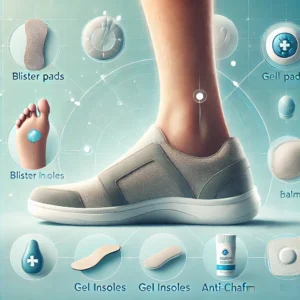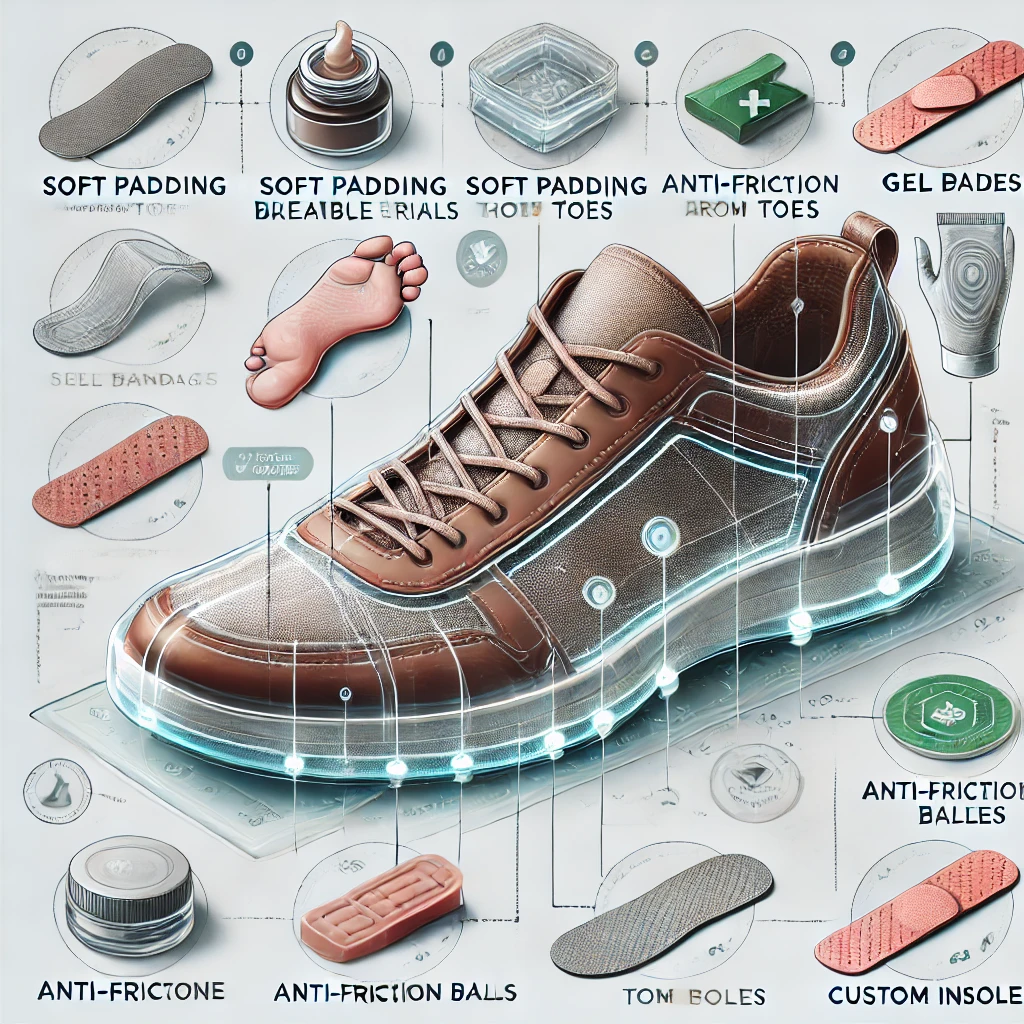Wondering how to stop shoes rubbing the top of toes? This common issue can cause significant discomfort, leading to blisters, calluses, and even long-term damage if left unaddressed. For additional tips on solving related issues, check out our guide on solving shoes rubbing on toes. Whether it’s due to ill-fitting shoes, poor design, or foot shape, finding the right solutions is essential for maintaining foot health. In this comprehensive guide, we’ll explore practical tips, immediate remedies, and preventative measures to help you stop shoes from rubbing and keep your feet comfortable every step of the way.

Common Causes of Shoes Rubbing the Top of Toes
Ill-fitting Shoes (Too Tight or Too Loose)
Shoes that don’t fit properly are the most common culprits. Tight shoes press down on the toes, creating constant friction, while loose shoes allow the feet to slide around, causing rubbing. Ensuring the right size is critical to avoiding these issues.
Poor Shoe Design or Materials
Stiff materials, poorly placed seams, or rigid structures in some shoe designs can directly irritate the top of your toes. Shoes that prioritize aesthetics over comfort often exacerbate this problem.
High Arches or Foot Shape Affecting Fit
People with high arches or uniquely shaped feet may find that standard shoe designs don’t accommodate their anatomy, leading to pressure points and rubbing. Custom solutions are often needed for such cases.
Lack of Padding or Support in Shoes
Shoes without sufficient cushioning or support fail to absorb the impact of walking or running, forcing the feet to bear the brunt of the pressure. This can lead to direct friction on the toes.
Immediate Remedies to Relieve Discomfort
Use Adhesive Bandages or Gel Pads
Applying adhesive bandages or gel pads over the affected area is a quick and effective way to reduce friction. These create a protective barrier between the shoe and your skin, minimizing discomfort.
Apply Anti-Friction Balms or Powders
Specialized balms or powders can reduce the friction between your skin and the shoe. They are especially useful for active individuals who need a reliable solution for extended wear.
Wear Protective Toe Caps or Sleeves
Protective toe caps or silicone sleeves offer an additional layer of cushioning for your toes. These are particularly helpful for those wearing rigid shoes like boots or dress shoes.
Long-Term Solutions to Prevent Rubbing
Invest in Properly Fitting Shoes
Properly fitting shoes are the cornerstone of foot comfort. Investing in high-quality shoes that align with your foot size and shape can save you from recurring issues like rubbing and discomfort.
Tips for Measuring Your Feet
- Measure your feet at the end of the day when they are slightly swollen for an accurate size.
- Use a Brannock device or consult a professional at a shoe store.
- Measure both feet, as one foot may be slightly larger than the other, and choose shoes to fit the larger foot.
Choosing the Right Shoe Size and Style
- Avoid shoes that pinch or leave excessive gaps.
- Opt for styles that match your daily activities, whether casual, athletic, or formal.
- Look for adjustable features like laces, buckles, or straps to customize the fit.
Opt for Shoes with Breathable and Flexible Materials
Breathable materials like leather, mesh, or knit fabric reduce friction by allowing natural foot movement and ventilation. Flexible materials adjust to your foot’s shape, preventing hard pressure points on the toes.
Use Shoe Stretchers or Professional Stretching Services
- Shoe stretchers can gently expand the toe box or other tight areas of your shoes.
- For stubborn materials, professional cobblers offer stretching services that ensure a perfect fit without damaging the shoe.

Quick Fixes for Immediate Relief
DIY Hacks to Modify Your Shoes
Softening Stiff Materials with Heat or Conditioning Sprays
- Use a hairdryer to warm stiff areas of the shoe, then flex or wear them to mold them to your feet.
- Apply leather conditioners or shoe-specific sprays to soften rigid materials, making them more comfortable over time.
Adding Custom Insoles or Padding to Reduce Pressure Points
- Use cushioned insoles designed for comfort and support, focusing on areas prone to rubbing.
- Foam or gel padding can be inserted into the shoe to reduce pressure on the toes.
Adjusting Laces for a Better Fit
- Experiment with different lacing techniques to relieve pressure on specific areas.
- Skip eyelets near the toes to reduce tightness or use elastic laces for a more adaptive fit.
These long-term solutions and DIY hacks ensure that your shoes become comfortable companions, not painful burdens.
Choosing the Right Socks
Importance of Moisture-Wicking and Cushioned Socks
Socks play a crucial role in preventing shoe friction. Moisture-wicking socks help keep your feet dry by drawing sweat away, reducing the risk of blisters. Cushioned socks provide additional padding, offering a barrier between the top of your toes and the shoe material.
Avoiding Seams That Can Irritate the Toes
Seams in socks, especially thick or poorly placed ones, can create pressure points on the toes. Opt for seamless socks or those with flat toe seams to ensure maximum comfort.
Recommendations for Toe-Friendly Sock Brands
- Bombas: Known for their cushioned and seamless designs.
- Darn Tough: Durable and moisture-wicking, perfect for active lifestyles.
- Smartwool: Offers breathable and cushioned options for long-lasting comfort.
- Injinji Toe Socks: Provide individual toe coverage, reducing friction and irritation.
Preventative Measures for Active Lifestyles
Best Practices for Runners and Hikers
- Invest in Proper Footwear: Use running or hiking shoes designed for your activity to ensure adequate support and fit.
- Break in New Shoes Gradually: Wear new shoes around the house or for short activities before taking them on extended runs or hikes.
- Use Anti-Friction Products: Apply balms, powders, or sprays before strenuous activities.
Specialized Footwear for Athletic Activities
- Running Shoes: Look for pairs with a roomy toe box and breathable materials.
- Hiking Boots: Opt for boots with reinforced toe protection and waterproof yet breathable designs.
- Cross-Training Shoes: These provide excellent versatility for gym or court activities, with added cushioning for multi-directional movement.
Rotating Shoes to Reduce Wear and Tear
Rotating between multiple pairs of shoes reduces the stress on a single pair, allowing each to retain its shape and cushioning longer. This practice also gives your feet a chance to adapt, reducing the risk of friction-related issues.
By choosing the right socks and following these preventative measures, you can maintain foot comfort and avoid painful rubbing, even during high-intensity activities.
Overview
| Section | Key Points |
|---|---|
| Introduction | – Shoes rubbing the top of toes can cause discomfort and long-term damage. |
| – Focus: How to stop shoes rubbing the top of toes. | |
| 1. Common Causes | – Ill-fitting shoes (too tight or loose). |
| – Poor shoe design or materials. | |
| – High arches or foot shape issues. | |
| – Lack of padding or support. | |
| 2. Immediate Remedies | – Use adhesive bandages or gel pads. |
| – Apply anti-friction balms or powders. | |
| – Wear protective toe caps or sleeves. | |
| 3. Long-Term Solutions | – Invest in properly fitting shoes (tips for measuring feet). |
| – Choose breathable and flexible materials. | |
| – Use shoe stretchers or professional stretching services. | |
| 4. DIY Hacks | – Soften stiff materials with heat or sprays. |
| – Add custom insoles or padding. | |
| – Adjust laces for a better fit. | |
| 5. Choosing the Right Socks | – Use moisture-wicking and cushioned socks. |
| – Avoid seams that irritate toes. | |
| – Recommendations: Thorlos, Feetures, Balega, etc. | |
| 6. Active Lifestyles | – Best practices for runners and hikers. |
| – Use specialized footwear for activities. | |
| – Rotate shoes to reduce wear and tear. | |
| 7. Professional Help | – When to see a podiatrist (persistent pain, blisters, infections). |
| – Custom orthotics and professional shoe modifications. | |
| – Addressing foot deformities or activity-specific needs. | |
| 8. FAQs | – Common questions: Causes of rubbing, fixing shoes without replacing, brands for toe comfort, etc. |
| 9. Conclusion | – Recap key solutions. |
| – Emphasize prioritizing foot comfort and care. |
When to Seek Professional Help
Sometimes, despite trying various remedies and solutions, the issue of shoes rubbing the top of your toes persists. Chronic discomfort or visible signs of damage can indicate that the problem is more complex than just ill-fitting footwear. Here are some scenarios where seeking professional advice becomes necessary:
Persistent Pain or Discomfort
If the rubbing causes consistent pain, swelling, or redness that doesn’t improve with at-home remedies, it could be a sign of an underlying issue, such as structural foot problems or improperly healed injuries.
Recurrent Blisters or Calluses
When blisters or calluses keep forming despite efforts to alleviate the problem, you may need guidance from a specialist. These conditions can lead to more severe foot issues if left untreated.
Skin Changes or Infections
Noticeable skin changes, such as discoloration, open sores, or signs of infection (e.g., redness, warmth, or oozing), require prompt medical attention. These symptoms might indicate that the skin barrier has been compromised, increasing the risk of complications.
Misalignment or Deformities
Foot conditions like bunions, hammertoes, or high arches often contribute to shoe discomfort. A podiatrist can assess whether custom orthotics, splints, or surgical interventions are necessary.
Customized Orthotic Solutions
A podiatrist or orthopedic specialist can create custom orthotics tailored to your foot shape. These inserts provide additional support, redistribute pressure, and reduce friction in problematic areas.
Professional Shoe Modifications
Specialists can professionally stretch or modify your shoes to improve fit and comfort. Some cobblers or orthopedic professionals offer adjustments that are more precise than DIY methods.
Addressing Sports or Activity-Related Pain
Athletes and individuals with active lifestyles may benefit from consulting a sports medicine specialist. They can recommend specialized footwear, gait analysis, or training adjustments to prevent recurring issues.
Frequently Asked Questions (FAQs)
To address common concerns, here are answers to some frequently asked questions about preventing shoes from rubbing the top of your toes:
1. Why do my shoes rub the top of my toes?
Shoes may rub the top of your toes due to poor fit, stiff materials, or insufficient padding. Structural foot issues like high arches or toe deformities can also contribute to friction. Identifying the cause is the first step to resolving the issue.
2. Can I fix rubbing shoes without buying new ones?
Yes, there are several ways to alleviate rubbing without replacing your shoes:
- Use adhesive bandages, gel pads, or toe sleeves for immediate relief.
- Apply anti-friction balms to reduce chafing.
- Stretch shoes at home using tools like shoe stretchers or heat-softening techniques.
- Add insoles or custom padding to improve the fit and comfort.
3. Are there specific brands known for toe-friendly shoes?
Yes, some brands prioritize comfort and cater to foot shapes that require extra room or cushioning. Popular options include:
- Hoka One One: Known for cushioned, supportive shoes for active lifestyles.
- Clarks: Offers wide toe boxes and soft materials.
- New Balance: Renowned for its variety of widths and arch-supporting designs.
- Altra: Specializes in foot-shaped designs with roomy toe boxes.
4. How can I stretch shoes at home safely?
You can stretch shoes using several DIY methods:
- Shoe Stretchers: Insert stretchers into your shoes and adjust them gradually for a better fit.
- Heat Method: Use a hairdryer to warm stiff areas of the shoes, then wear them with thick socks to mold them to your feet.
- Conditioning Sprays: Apply sprays designed to soften materials before stretching.
Avoid over-stretching, as this can damage the shoes.
5. What type of socks should I wear to prevent rubbing?
Choose socks that are:
- Moisture-Wicking: To keep feet dry and reduce friction.
- Cushioned: For extra padding and protection.
- Seam-Free: To avoid irritating sensitive areas.
Brands like Thorlos, Feetures, and Balega offer excellent options for comfort and support.
6. When should I consider consulting a podiatrist?
If the rubbing causes persistent pain, recurring blisters, or signs of infection, consult a podiatrist. They can diagnose underlying foot issues, recommend orthotics, or suggest other treatments to address the problem effectively.
7. Can I prevent rubbing during athletic activities?
Yes, here are some tips for active individuals:
- Invest in specialized athletic footwear designed for your activity.
- Use anti-friction balms or powders before exercising.
- Rotate shoes to ensure even wear and maintain their integrity.
- Break in new shoes gradually to avoid discomfort.
8. Is it possible to prevent rubbing in high heels?
Preventing rubbing in high heels involves:
- Choosing styles with padded insoles and adjustable straps.
- Adding gel inserts or toe cushions for extra support.
- Opting for lower heels or wedge designs to reduce pressure on toes.
Conclusion
Foot discomfort caused by shoes rubbing the top of your toes is a common issue, but it doesn’t have to be a permanent one. By understanding the root causes and exploring both immediate remedies and long-term solutions, you can prioritize your foot health and comfort.
From investing in properly fitting shoes to trying out DIY hacks and preventative measures, there are countless ways to address this problem. Don’t underestimate the importance of small changes, like selecting toe-friendly socks or modifying your lacing techniques, as they can make a significant difference.
If discomfort persists despite your efforts, seeking professional help can provide tailored solutions, ensuring long-term relief and preventing further damage. Your feet carry you through life, and their care is an investment in your overall well-being.
By applying the strategies outlined in this guide, you’ll be well-equipped to stop shoes from rubbing the top of your toes, enjoy pain-free movement, and make the most of your daily activities.

